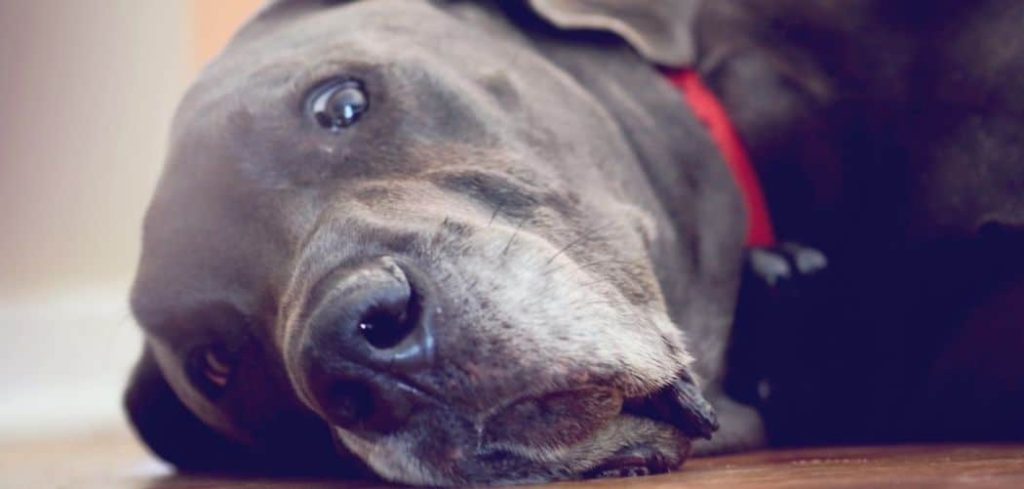Great Danes are known for their majestic size, gentle nature, and deep loyalty to their owners.
Unfortunately, as with all giant breeds, they have a shorter lifespan compared to smaller dogs, typically living between 7 to 10 years.
As a Great Dane owner, it’s heartbreaking to watch your beloved companion age or suffer from illness.
If you’re asking yourself, “Is my Great Dane dying?” it’s essential to understand the signs, know when to seek veterinary help, and learn how to make their final days as comfortable as possible.
Signs That Your Great Dane May Be Nearing the End
While some health problems can be managed, certain signs indicate that your Great Dane may be nearing the end of their life. Recognizing these signs early can help you make informed decisions about their care and quality of life.

1. Decreased Appetite and Weight Loss
A once voracious eater refusing food or eating very little is a significant warning sign.
Weight loss can also accompany a reduced appetite, especially if they are struggling with a chronic illness or cancer.
2. Difficulty Breathing
Labored breathing, persistent coughing, or wheezing may indicate heart failure, lung disease, or another severe condition.
If your Great Dane struggles to breathe, immediate veterinary attention is needed.
3. Decreased Mobility and Weakness
Large breeds like Great Danes are prone to arthritis, hip dysplasia, and degenerative myelopathy.
If your dog is struggling to get up, limping excessively, or collapsing, it may be a sign that their body is shutting down.
4. Changes in Behavior
A dying Great Dane may isolate themselves, become less responsive, or show signs of confusion.
They might also experience increased anxiety or clinginess, seeking extra comfort from their owners.
5. Incontinence and Loss of Bladder/Bowel Control
Dogs in their final stages may lose control of their bladder and bowels.
This can be distressing for both the pet and the owner but is a common sign of a weakening body.
6. Chronic Pain
If your Great Dane shows signs of persistent pain—whimpering, reluctance to move, stiffness, or a hunched posture—despite pain management efforts, it might be time to consider their quality of life.
7. Lethargy and Withdrawal
A Great Dane who is nearing the end may sleep excessively and show little interest in their surroundings.
They may stop greeting you at the door, playing, or engaging in activities they once loved.
Related: Why is my Great Dane Having Seizures? Here’s Why
Common Health Issues That Lead to End-of-Life Decline
Several health conditions can contribute to a Great Dane’s decline.
Some of the most common include:
1. Bloat (Gastric Dilatation-Volvulus – GDV)
Bloat is a life-threatening emergency where the stomach twists, cutting off blood supply.
If your Great Dane exhibits restlessness, an enlarged abdomen, unsuccessful attempts to vomit, or signs of extreme distress, immediate veterinary care is critical.
2. Dilated Cardiomyopathy (DCM)
Great Danes are prone to heart disease, particularly DCM, which leads to heart failure.
Symptoms include coughing, difficulty breathing, fainting, and a distended belly due to fluid buildup.
3. Cancer
Bone cancer (osteosarcoma) is common in Great Danes. Symptoms include limping, swelling, and persistent pain.
Other cancers, such as lymphoma or mast cell tumors, can also lead to a decline in health.
4. Arthritis and Joint Problems
Chronic pain from arthritis or hip dysplasia can severely impact mobility and quality of life.
If pain management no longer helps, euthanasia may be the kindest option.
5. Neurological Disorders
Degenerative myelopathy or other neurological conditions can lead to progressive paralysis, affecting a dog’s ability to walk or even stand.
Related: Is my Great Dane depressed?
Assessing Your Great Dane’s Quality of Life
One of the hardest decisions a dog owner will ever face is knowing when it’s time to let go. The Hurt, Hunger, Hydration, Hygiene, Happiness, Mobility, and More Good Days Than Bad scale is a helpful tool to evaluate your dog’s quality of life.
Pain Level – Is your Great Dane in chronic pain that is no longer manageable?
Appetite – Are they refusing food and water?
Hygiene – Are they soiling themselves and unable to keep clean?
Happiness – Do they still enjoy things they once did?
Mobility – Can they get up, walk, and function without extreme difficulty?
Good Days vs. Bad Days – Are bad days outnumbering good days?
If your Great Dane is experiencing severe pain and a poor quality of life, euthanasia might be the most humane decision.
Providing Comfort in Their Final Days
If your Great Dane is nearing the end, you can make their final days peaceful and comfortable by following these steps:
1. Pain Management
Work with your veterinarian to provide effective pain relief. Medications, joint supplements, and CBD oil may help ease discomfort.
2. Soft and Warm Bedding
A comfortable place to rest, such as an orthopedic bed, can help ease pressure on their joints and provide warmth.
3. Gentle Exercise and Support
If mobility is an issue, help them move around with a sling or harness. Keep them engaged with gentle affection and short walks if they can handle it.
4. Maintain Hygiene
If they have accidents, clean them gently to prevent sores or infections. Grooming and brushing can also be soothing.
5. Offer Favorite Foods
If your dog still has an appetite, provide their favorite foods, even if they are usually off-limits.
Hydration is also essential, so encourage drinking water or offer ice cubes.
6. Provide Emotional Support
Your presence is the most comforting thing to your dog.
Spend time with them, talk to them in a soothing voice, and reassure them with gentle petting.
When to Say Goodbye
Making the decision to euthanize a beloved pet is heartbreaking. If your Great Dane is suffering, unable to enjoy life, or experiencing persistent pain, euthanasia can be the most compassionate choice.
Discuss with your veterinarian about options for in-home euthanasia or a peaceful, painless process at the clinic.
Final Thoughts
Saying goodbye to a Great Dane is never easy. Recognizing the signs of a dying pet and providing them with comfort, love, and dignity in their final days is one of the greatest acts of kindness you can offer. Lean on your veterinarian for guidance, cherish the moments you have left, and know that your Great Dane felt your unwavering love until the very end.
Sources
American Kennel Club (AKC): Great Dane Health Issues
Veterinary Partner: End-of-Life Care for Dogs
PetMD: Signs Your Dog is Dying
